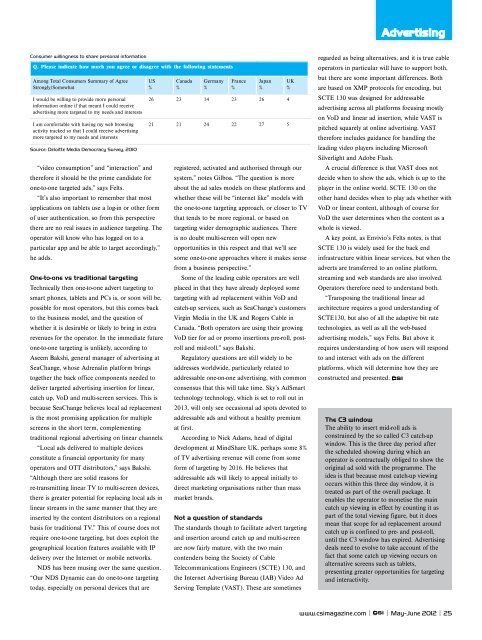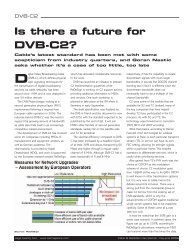Broadcasting the 2012 Olympic Games - CSI Magazine
Broadcasting the 2012 Olympic Games - CSI Magazine
Broadcasting the 2012 Olympic Games - CSI Magazine
Create successful ePaper yourself
Turn your PDF publications into a flip-book with our unique Google optimized e-Paper software.
Advertising<br />
Consumer willingness to share personal information<br />
Q. Please indicate how much you agree or disagree with <strong>the</strong> following statements<br />
Among Total Consumers Summary of Agree<br />
Strongly/Somewhat<br />
I would be willing to provide more personal<br />
information online if that meant I could receive<br />
advertising more targeted to my needs and interests<br />
I am comfortable with having my web browsing<br />
activity tracked so that I could receive advertising<br />
more targeted to my needs and interests<br />
Source: Deloitte Media Democracy Survey, 2010<br />
US<br />
%<br />
“video consumption” and “interaction” and<br />
<strong>the</strong>refore it should be <strong>the</strong> prime candidate for<br />
one-to-one targeted ads,” says Felts.<br />
“It’s also important to remember that most<br />
applications on tablets use a log-in or o<strong>the</strong>r form<br />
of user au<strong>the</strong>ntication, so from this perspective<br />
<strong>the</strong>re are no real issues in audience targeting. The<br />
operator will know who has logged on to a<br />
particular app and be able to target accordingly,”<br />
he adds.<br />
One-to-one vs traditional targeting<br />
Technically <strong>the</strong>n one-to-one advert targeting to<br />
smart phones, tablets and PCs is, or soon will be,<br />
possible for most operators, but this comes back<br />
to <strong>the</strong> business model, and <strong>the</strong> question of<br />
whe<strong>the</strong>r it is desirable or likely to bring in extra<br />
revenues for <strong>the</strong> operator. In <strong>the</strong> immediate future<br />
one-to-one targeting is unlikely, according to<br />
Aseem Bakshi, general manager of advertising at<br />
SeaChange, whose Adrenalin platform brings<br />
toge<strong>the</strong>r <strong>the</strong> back office components needed to<br />
deliver targeted advertising insertion for linear,<br />
catch up, VoD and multi-screen services. This is<br />
because SeaChange believes local ad replacement<br />
is <strong>the</strong> most promising application for multiple<br />
screens in <strong>the</strong> short term, complementing<br />
traditional regional advertising on linear channels.<br />
“Local ads delivered to multiple devices<br />
constitute a financial opportunity for many<br />
operators and OTT distributors,” says Bakshi.<br />
“Although <strong>the</strong>re are solid reasons for<br />
re-transmitting linear TV to multi-screen devices,<br />
<strong>the</strong>re is greater potential for replacing local ads in<br />
linear streams in <strong>the</strong> same manner that <strong>the</strong>y are<br />
inserted by <strong>the</strong> content distributors on a regional<br />
basis for traditional TV.” This of course does not<br />
require one-to-one targeting, but does exploit <strong>the</strong><br />
geographical location features available with IP<br />
delivery over <strong>the</strong> Internet or mobile networks.<br />
NDS has been musing over <strong>the</strong> same question.<br />
“Our NDS Dynamic can do one-to-one targeting<br />
today, especially on personal devices that are<br />
Canada<br />
%<br />
Germany<br />
%<br />
France<br />
%<br />
Japan<br />
%<br />
26 23 14 23 26 4<br />
21 21 24 22 27 5<br />
UK<br />
%<br />
registered, activated and authorised through our<br />
system,” notes Gilboa. “The question is more<br />
about <strong>the</strong> ad sales models on <strong>the</strong>se platforms and<br />
whe<strong>the</strong>r <strong>the</strong>se will be “internet like” models with<br />
<strong>the</strong> one-to-one targeting approach, or closer to TV<br />
that tends to be more regional, or based on<br />
targeting wider demographic audiences. There<br />
is no doubt multi-screen will open new<br />
opportunities in this respect and that we’ll see<br />
some one-to-one approaches where it makes sense<br />
from a business perspective.”<br />
Some of <strong>the</strong> leading cable operators are well<br />
placed in that <strong>the</strong>y have already deployed some<br />
targeting with ad replacement within VoD and<br />
catch-up services, such as SeaChange’s customers<br />
Virgin Media in <strong>the</strong> UK and Rogers Cable in<br />
Canada. “Both operators are using <strong>the</strong>ir growing<br />
VoD tier for ad or promo insertions pre-roll, postroll<br />
and mid-roll,” says Bakshi.<br />
Regulatory questions are still widely to be<br />
addresses worldwide, particularly related to<br />
addressable one-on-one advertising, with common<br />
consensus that this will take time. Sky’s AdSmart<br />
technology technology, which is set to roll out in<br />
2013, will only see occasional ad spots devoted to<br />
addressable ads and without a healthy premium<br />
at first.<br />
According to Nick Adams, head of digital<br />
development at MindShare UK, perhaps some 8%<br />
of TV advertising revenue will come from some<br />
form of targeting by 2016. He believes that<br />
addressable ads will likely to appeal initially to<br />
direct marketing organisations ra<strong>the</strong>r than mass<br />
market brands.<br />
Not a question of standards<br />
The standards though to facilitate advert targeting<br />
and insertion around catch up and multi-screen<br />
are now fairly mature, with <strong>the</strong> two main<br />
contenders being <strong>the</strong> Society of Cable<br />
Telecommunications Engineers (SCTE) 130, and<br />
<strong>the</strong> Internet Advertising Bureau (IAB) Video Ad<br />
Serving Template (VAST). These are sometimes<br />
regarded as being alternatives, and it is true cable<br />
operators in particular will have to support both,<br />
but <strong>the</strong>re are some important differences. Both<br />
are based on XMP protocols for encoding, but<br />
SCTE 130 was designed for addressable<br />
advertising across all platforms focusing mostly<br />
on VoD and linear ad insertion, while VAST is<br />
pitched squarely at online advertising. VAST<br />
<strong>the</strong>refore includes guidance for handling <strong>the</strong><br />
leading video players including Microsoft<br />
Silverlight and Adobe Flash.<br />
A crucial difference is that VAST does not<br />
decide when to show <strong>the</strong> ads, which is up to <strong>the</strong><br />
player in <strong>the</strong> online world. SCTE 130 on <strong>the</strong><br />
o<strong>the</strong>r hand decides when to play ads whe<strong>the</strong>r with<br />
VoD or linear content, although of course for<br />
VoD <strong>the</strong> user determines when <strong>the</strong> content as a<br />
whole is viewed.<br />
A key point, as Envivio’s Felts notes, is that<br />
SCTE 130 is widely used for <strong>the</strong> back end<br />
infrastructure within linear services, but when <strong>the</strong><br />
adverts are transferred to an online platform,<br />
streaming and web standards are also involved.<br />
Operators <strong>the</strong>refore need to understand both.<br />
“Transposing <strong>the</strong> traditional linear ad<br />
architecture requires a good understanding of<br />
SCTE130, but also of all <strong>the</strong> adaptive bit rate<br />
technologies, as well as all <strong>the</strong> web-based<br />
advertising models,” says Felts. But above it<br />
requires understanding of how users will respond<br />
to and interact with ads on <strong>the</strong> different<br />
platforms, which will determine how <strong>the</strong>y are<br />
constructed and presented.<br />
The C3 window<br />
The ability to insert mid-roll ads is<br />
constrained by <strong>the</strong> so called C3 catch-up<br />
window. This is <strong>the</strong> three day period after<br />
<strong>the</strong> scheduled showing during which an<br />
operator is contractually obliged to show <strong>the</strong><br />
original ad sold with <strong>the</strong> programme. The<br />
idea is that because most catch-up viewing<br />
occurs within this three day window, it is<br />
treated as part of <strong>the</strong> overall package. It<br />
enables <strong>the</strong> operator to monetise <strong>the</strong> main<br />
catch up viewing in effect by counting it as<br />
part of <strong>the</strong> total viewing figure, but it does<br />
mean that scope for ad replacement around<br />
catch up is confined to pre- and post-roll,<br />
until <strong>the</strong> C3 window has expired. Advertising<br />
deals need to evolve to take account of <strong>the</strong><br />
fact that some catch up viewing occurs on<br />
alternative screens such as tablets,<br />
presenting greater opportunities for targeting<br />
and interactivity.<br />
www.csimagazine.com May-June <strong>2012</strong> 25






